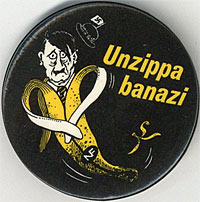It’s not junk. It’s history
Roula Khalaf, Editor of the FT, selects her favourite stories in this weekly newsletter.
I have spent the past couple of weeks clearing out my childhood bedroom, where I lived from the ages of seven to 18, and which acted as a refuge during the odd turbulent patch of early adulthood. For reasons too complicated to explain, the room has remained intact since those days. To walk into it at any time over the past three decades was to stumble into a Sir John Soane’s Museum of the mid-20th century, replete with the music, literature and ephemera of that time. What I have always regarded as junk has, with the passage of time, been relabelled “memorabilia”. Some of it, I learn, is valuable. All of it has a story to tell.
So here, in the spirit of the British Museum-BBC project A History of the World in 100 Objects, is a selection of things that I came across: a history of a corner of west London in 10 keepsakes, and what they may tell us about the passing of the past half-century:
1. An invitation from Matthew Roe to his 10th birthday party (how on earth are you, Matthew?) in 1968, which told us we were to be taken to see the freshly released The Charge of the Light Brigade. There are many adjectives that can be applied to Tony Richardson’s film – turgid, static, melancholy – but child-friendly is not one of them. Did we really manage to sit still for the whole charge? Parents, thank the Lord for Pixar.
2. A facsimile of a British pound note featuring a group portrait of Abba in place of the Queen. This is from an era that thought the exclusive pursuit of “Money, Money, Money” was so ridiculous, you could write a satirical hit song about it (“Must be funny, in the rich man’s world!”). About as funny as the charge of the Light Brigade. Besides, isn’t it illegal to mess with the currency? Does the Queen know about this?
3. A stash of unused Christmas cards that were stamped “British Embassy, Washington” (where my father had worked) on the front. The colour photograph inside the card shows President Kennedy declaring Sir Winston Churchill an honorary citizen of the US. The date of the photograph is April 9 1963. Something happened between April and December which meant that the cards didn’t get sent. You can plan your Christmases too early.
4. Issue number 7, dated 1983, of Granta magazine, dedicated to the “best of young British novelists”. Here is that now-famous roll-call: Martin Amis, Pat Barker, Julian Barnes, William Boyd, Kazuo Ishiguro, Ian McEwan, Salman Rushdie, Graham Swift, Rose Tremain, and more. I like the authors’ brief biographical notes: “Ishiguro lives in London, where he sleeps during the day, and eats enormous quantities of food at night. He is of samurai descent.”
5. Four albums by Mike Nesmith. From The Monkees. You remember, the tall Texan with the woolly hat and edgy sense of humour. Turns out he was a decent musician, with a very pleasant line in light country music. But four albums? He, at least, knew his limitations. He called his 1973 album Pretty Much your Standard Ranch Stash, which sums him up nicely. I looked up its highest position in the Billboard chart online, and there was a dismissive dash in place of a number: did no one buy it apart from me?

6. A “Don’t Badger the Badger” badge, which I am sorry to say I used to wear because of the sharp word-play rather than any feelings about the plight of the plucky animal. The campaign was evidently a failure: far from being merely badgered, badgers are currently being blown away with high-velocity rifles in a countryside near you. The fightback starts here.
7. An “Unzippa Banazi” badge, with a picture of Adolf Hitler emerging from a banana skin. Don’t ask me.

8. A matchbox from Greece, illustrated by a portrait of that country’s revolutionary hero, Theodoros Kolokotronis, commemorating the 150th anniversary of the 1821 uprising against Ottoman rule. That is only on one side, though. On the other is a drawing of a phoenix, a mythological symbol of rebirth, which is partly covered by the silhouette of an armed soldier. These were the years of the military junta in Greece, and this sinister and barely coherent mash-up of images gives you some idea of the regime’s intellectual rigour. No wonder Greeks still smoke.

9. A small black-and-white photograph of the actress Ann Sheridan, given to my mother by my father as a forget-me-not in the 1940s. I find it strange that, amid the drama of a real-life wartime romance, feelings of love should have been mediated via an image of a movie star. It was an early intimation of the power of celebrity culture, which today tramples all over us, and it explained Andy Warhol to me.
10. A copy of John Lennon’s Imagine, complete with the little picture postcard of him holding a pig by its ears, a famously dismissive dig at his fellow Beatle Paul McCartney. “Imagine no possessions” is its very first line.
He could have picked a better time to ask me.
——————————————-
Twitter: @peteraspden
To listen to culture columns, visit ft.com/culturecast
Comments